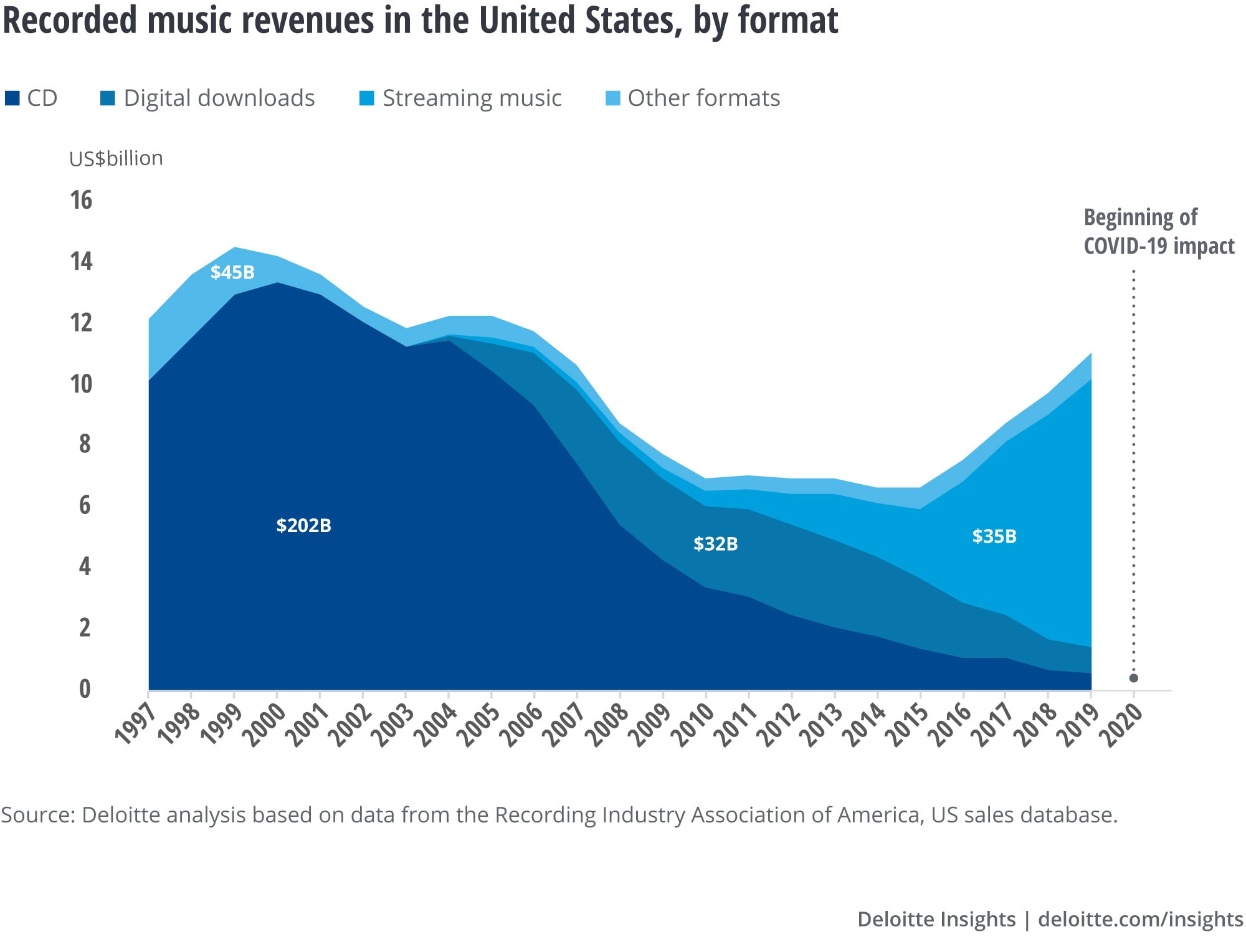How streaming is changing the music industry As COVID-19 halts live events, music streaming platforms innovate
4 minute read
11 June 2020
Heading into 2020, streaming was driving the music industry toward a new high. Then came the COVID-19 pandemic, which canceled tours, concerts, and album releases. Can streaming platforms help the industry weather the storm?

Earlier this year, the recorded-music industry appeared to be on track to recover from a long slump, thanks to the emergence of music streaming. From 2015 to 2019, overall recorded music revenues, driven largely by streaming, posted a compound annual growth rate (CAGR) of 13%, reaching US$11.1 billion in annual revenue (see figure). In 2019, by far the industry’s best year in a decade, streaming accounted for 80% of revenues.1
Learn more
Read the latest charticle on baby boomers and technology
Explore the Thinking Fast series library
Subscribe and never miss a charticle
Learn about Deloitte's services
Go straight to smart. Get the Deloitte Insights app
More people were listening on speakers and through earbuds—and they went to shows as well: The US live music and concert industry also experienced strong growth in 2019, with trends on track for another great year in 2020.2 And then COVID-19 struck, postponing or canceling music events and concerts large and small, wreaking a devastating financial impact.3 The concert industry could lose an estimated US$9 billion if COVID-19 quarantines are not lifted by the end of 2020.4
Suddenly, streaming platforms now shoulder an additional responsibility: With earnings from live music and concerts mostly shrunk to tips from webcasts,5 artists are increasingly relying on income from streaming platforms.
Over the past several years, artists have been increasingly vocal about not receiving fair compensation from certain music streaming platforms.6 Now, some platforms are making amends and offering direct or indirect financial assistance to support the music community during these trying times. Spotify has launched a feature that allows artists to fundraise through their Spotify profiles,7 while YouTube’s “Stay Home #WithMe” campaign enables artists to post and stream their content to fans from home. In addition to its ad-supported monetization for artists, YouTube is letting fans donate directly to the creators.8
Some music platforms are innovating by hosting virtual concerts for artists.9 While it may be impossible to re-create the concert experience in a living room, many digital platforms are bringing artists closer to fans. Tidal, for example, is offering consumers free access to virtual concerts as part of its “At Home with Tidal” program.10 New competitors are getting into the space as well: Instagram has emerged as a popular platform among artists, with some live performances garnering more than 100,000 live views;11 Travis Scott’s free virtual concert inside Epic Games’ Fortnite attracted a staggering 12 million viewers.12
Streaming platforms have witnessed increased social engagement, subscriptions, and artist activity through their COVID-19 innovations. Will they be able to continue engaging fans not just during virtual concerts but before and after them? Can virtual concerts and social performances help artists recoup at least some of their lost tour revenue? And can streaming platforms grow their own revenues while enabling these features for the music community?
The answers to these questions may lie in streaming platforms’ ability to innovate, continue hosting popular virtual events, increase consumer engagement and loyalty, and efficiently monetize their offerings. Streaming players have successfully done that to an extent during the current crisis. The learnings from this crisis will likely help them scale up further and play a significant role in the growth of music industry going forward.
© 2021. See Terms of Use for more information.
More from the Technology collection
-
The changing face of North America’s tech ecosystem Article5 years ago
-
M&A premiums surge as pool of targets subsides Article5 years ago
-
Talent and workforce effects in the age of AI Article5 years ago
-
Tech Trends 2025 Article4 months ago
-
TMT Predictions 2025 Article5 months ago













